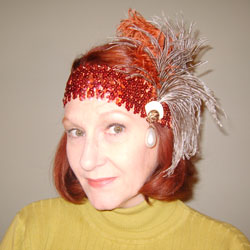
Margie Wagner is a cheery gal. Maybe that’s why she loves hats. She wears them all the time—not just to church (she’s Catholic and used to the tradition), but to cocktail parties, the symphony and to meetings. She wears them so often, in fact, that when she doesn’t, her friends will ask her “Why aren’t you wearing a hat tonight?”
Linda Bradshaw, also a hat aficionado, says hats make her feel good. She’s wearing a white faux fur variation on a Russian ushanka this winter and has just picked out a herringbone wool visor cap at Moon Dancer in Peoria Heights, one of her favorite hat sources.
And, I have to admit, I have a soft, mink-brown felt hat—a slouch fedora with a wide brim—that I got in Greenwich Village in New York City ages ago. When I wear it, I push one side up and feel like Greta Garbo or Marlene Dietrich. That’s why I like hats—they bring out one’s thespian side. They let me play a character—all those I might have been had my life taken a different track.
Hats are the first thing people notice because we tend to first look at a person’s face. Don’t we all want a little more attention? Especially in February?
Wagner says, “People tell me all the time ‘I love your hat.’ Especially men say it.
“‘Why don’t you wear a hat?’ I ask the women I meet, and you know what they say? ‘Oh, not me, I don’t look good in a hat.’ Well just put one on and try it, I tell them.’”
Wagner has been encouraging people to wear hats, waging her own campaign for years. She’s not talking fuzzy, close-fitting winter knits that keep you warm. No, she means fun hats. Cheeky ones. Beautiful ones. “It will make you happy,” she says. “You just feel bright and cheery—especially in a colorful hat.”
Bradshaw agrees, “You have to get used to seeing yourself in a hat. Besides, if you have bad hair, all you need is a good hat!” When I work with the models in the Peoria Historical Society Style Show, where we costume contemporary women to portray women in Peoria’s past, the first question the models usually ask is—“Do I get to wear a hat?” Indeed, most of them do.
Whether it be the headbands of standing ostrich plumes worn in the 1830s to counteract the wide-shouldered, full-skirted dresses; the silk poke bonnets of the 1850s with brims that fit down over the sides of the face, shielding the wearer from the gaze of strangers and room at the back of the hat to poke her hair up inside; the 1880s’ stovepipe hats decorated with bird feathers and ribbons; the oversized, turn-of-the-century Titanic hats with wide brims layered in lace and flowers or the large-crown, elaborately decorated Merry Widows; an exotic Poiret turban matched with a form-fitting Fortuny dress in the early 1900s; or the deep ruby red felt clouch of the 1920s, the models wear them with panache.
If hats were “invented,” the originator was a cavewoman. The minute she stepped from her cave, she needed something over her head to protect her from the elements and falling rocks. One hundred thousand or so years later, she watched as the men in her community wore hats as symbols of authority. Finally, in the late 1700s, women’s hats became fashion items—art forms, in fact.
Throughout the 19th century, hat styles changed with the fullness of skirts, the size of sleeves and shoulders, and attitudes of behavior expected of women.
By 1900, women changed their hats several times a day, depending on the activity at hand. The First World War changed habits, and hat styles followed. In the ‘20s, more women took up golf and swimming, and hats became sportier. Useful, head-hugging hats worn farther back from the face were the rage in the ‘30s.
With the Second World War, and the need to rush to an air raid shelter when the sirens blared, hats became quite impractical, and by the end of the war, pricey. Late in the decade, women dismissed the “hats for decency” principle forever. The ‘50s returned women to their homes, habits changed again and dressy hats were worn for semiformal occasions. In the ‘60s, we all fell for Jackie Kennedy, who wore small hats with elegance and distinction, and women around the world dashed to the closest department store to buy a pillbox, preferably with a small net over the brow.
In the ‘80s, we were inspired once again by Princess Diana, who took to wearing hats, so we’re told, to make herself appear more sophisticated, and abandoned them as her self-confidence grew.
In recent years, it is Victoria Beckham who champions showy hats, choosing a gorgeous, black, Audrey Hepburn picture hat from designer Philip Treacy for a recent event.
Here in Peoria, we’re inspired by forerunners like Margie Wagner and Linda Bradshaw, the members of the Red Hat Society, and all of the women who don hats at church on Sundays.
You may not find stylish, perky hats at regular stores. No, you have to keep an eye open for vintage sales and visit specialty shops like Moon Dancer. Recently, www.shopgoodwill.com offered a lime green, ‘50s pancake Panama-style straw hat with a flat crown, small bow and a six or seven-inch brim—Divine! TPW
